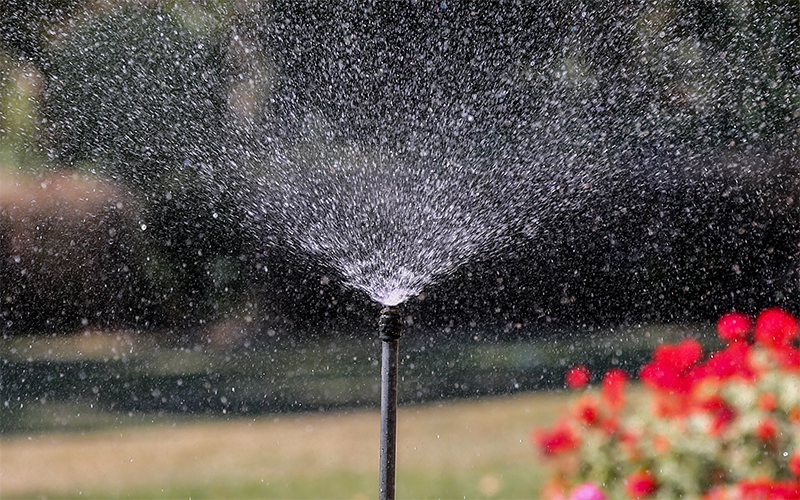
Experts recommend checking your irrigation at least once a month to make sure it’s efficient and that there are no leaks. (Photo by Dinendra Haria/SOPA Images/Shutterstock)
PHOENIX – The Southwest’s megadrought has put the spotlight on water conservation, and experts agree it’s a crucial part of the solution. But what does conservation mean to the average Arizonan?
Shorter showers? No more grass lawns?
What really matters might surprise you.
Let’s say you’re standing at the kitchen sink with an empty peanut butter jar. You want to put it in the recycling bin, but you need to rinse it out first. Is it worth the water?
In our daily lives, there are many ways to save water, such as turning off the faucet when we brush our teeth or taking shorter showers. These are nice gestures, but to really save water, said Sarah Porter of the Kyl Center for Water Policy at Arizona State University’s Morrison Institute, we need to think bigger.
“If everybody in Phoenix saved a gallon of water a week by not rinsing out containers, it would not help the problem,” she said.
It’s not like there’s a straw from Lake Mead to your kitchen sink.
“These kinds of efforts, they’re fine – it’s good for people to be very water-conscious,” Porter said. “I really believe in that and support that. But they’re not connected to the solutions.”
First, it helps to understand that the water you use to clean that peanut butter jar will be reclaimed and put to use.
“Almost all the water going down the drain is going to be recycled – 93%,” Porter said.
Arizona has been storing water for more than a century. Many communities get their water from a variety of places besides the Colorado River, such as groundwater and the Salt, Verde and Gila rivers. Every city is different.
“Reducing your consumption of water enables your city to stretch the water supplies in hand, over a larger number of users,” Porter said. “And it’s very important to recognize that. It doesn’t do anything else. It doesn’t leave water in Lake Mead or Lake Powell.”
Conservation is important because it helps cities as they plan, swap water and build infrastructure. But what’s the best way for the average person to help?
Look outside, what do you see? Desert landscaping? Grass? A sprinkler running at high noon?
“Actually, most of your water use is still outdoors,” said Max Wilson, water conservation coordinator for Phoenix. Even desert landscaping can get too much water, he said.
“A lot of our residents are radically overwatering,” he said. “When it comes down to how much water does your grass need or your bushes need, most of us are just guessing.”
Wilson recommends checking your irrigation controller once a month. If your system is just a sprinkler with a hose, that’s fine, too.
“These systems can work really, really well, as long as you don’t forget about them,” he said. “And that’s the number one challenge that folks have is leaving that sprinkler on overnight, or maybe into the next morning.”
There also are things you can do inside the home, such as repairing leaks and installing water-efficient appliances.
Craig Caggiano, water resources manager for Tempe, said the city has experts who can help with such things as landscaping or rainwater capture.
Most of Tempe’s water comes from the Salt River, which has proven more stable than Mead and Powell during the two-decades long drought, but the city remains committed to conservation.
“It’s a regional issue. Tempe can’t sit alone on an island,” Caggiano said.
The state has been planning on drought – even a severe one – for decades. What it didn’t plan for was the complexities of global climate change and their effects on snowpack in the Colorado River Basin. But Arizona uses about the same amount of water as it did in 1957, and conservation has played a big role in that.
“Individual actions matter to conservation,” Caggiano said. “These actions are how we’ll achieve a future with less Colorado River water. The small actions that everyone can make in their residence or at their business all add up.”
Although the idea of large cities in the desert seems counterintuitive, about 75% of the water in the Lower Basin of the Colorado goes to agriculture. Porter said it’s important not to attach value judgments to these different uses of water, but the numbers can help increase our understanding of water and guide policy and planning.
When cities do save water, they sometimes use it to meet new demand. Las Vegas paid people to rip out lawns so the city could have more water for development. These are the kinds of choices that planners will continue to make moving forward.
“We live in the desert,” Caggiano said. “We moved here because we like the desert, and it’s important to respect that as we consider these shortages on the Colorado River and a potential future with less Colorado River water.”
So, if you leave the water running for a few seconds while you brush your teeth, don’t freak out. But do check the sprinkler.